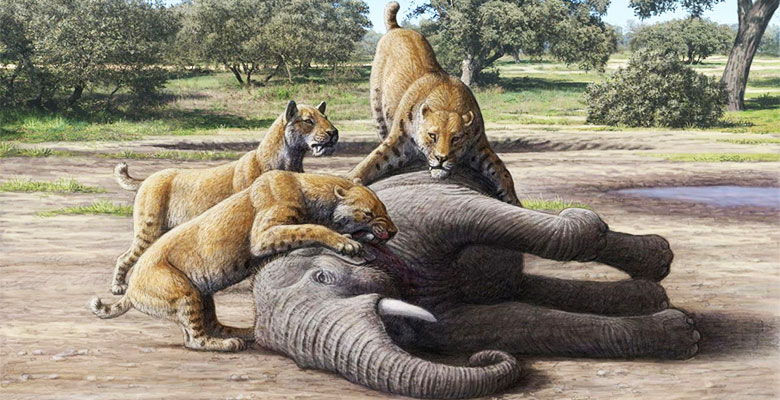Prehistoric predators kept large animals in check and shaped ecosystem

Our prehistoric ancestors may have had large carnivores – giant lions, saber-tooth cats, bears and hyenas up to twice the size of their modern relatives – to thank for an abundance and diversity of plants and wildlife. Likewise, modern ecosystems, from tropical forests to the American West, may depend on the ability of large carnivores to control grazing animals.
Those are among the conclusions of scientists who used ice-age fossils and historical data from modern surveys of animal populations to investigate the nature of predator-prey relationships. Researchers led by Professor Blaire Van Valkenburgh UCLA (University of California, Los Angeles) published their findings today in the Proceedings of the National Academy of Sciences.
Dr Carlo Meloro, Lecturer in Vertebrate Palaeontology, Natural Sciences and Psychology at Liverpool John Moores University is among the co-authors.
Dr Carlo Meloro, explained:
”We knew that during the Ice Age remarkable predators were roaming free all over Europe and North America. In this study, we had the opportunity to summarise multiple evidences from modern ecology and palaeontology to suggest these predators might have strongly impacted populations of wild large herbivores in the prehistory.
“I measured many fossil bones of large Pleistocene carnivores, and it was always striking to realise how modern species like spotted hyenas in the past were almost doubling in size. Such adaptation to a colder climate at northern latitudes gave to the Pleistocene predators also stronger powerful attributes to bring down prey much larger than themselves.”
Professor of ecology at Oregon State University’s College of Forestry, William Ripple said:
“Large predators can have a major role in limiting their prey and in determining the structure and function of ecosystems. But scientists have thought that the largest herbivores, such as elephants, were immune from predation. We now know that’s not the case, and based on these data from the Pleistocene (the epoch which lasted from about 2.5 million to 11,700 years ago), we now think that large carnivores did limit the large herbivores at that time.”
Using Pleistocene fossils, the researchers concluded that juvenile members of large herbivores – such as woolly mammoths and giant bison, sloths and camels — were well within the size range of prey available to the carnivores that roamed the landscape.
The researchers synthesised data on predator and prey body masses, historical data on group size in large carnivores and palaeontological data on ancient carnivores. Their analysis of data on more than 50,000 individual kills in the wild enabled them to predict the probable prey sizes of the extinct predators using a mathematical model derived from modern data. They estimated the body mass of young mammoths and mastodons using data on the relationship between shoulder height and age and, for living elephants, shoulder height and mass.
Today in Africa, lions do prey on young elephants, but since lions have declined dramatically in pride size and geographic range, they are not thought to provide an ecologically effective control on elephant populations. Safari hunting parties and explorers recorded prides containing an average of 24 and as many as 40 animals in the late 1800's, but today, lion prides have dwindled to an average of nine animals, based a recent analysis of 27 African reserves.
The findings have implications for modern wildlife management policies, the authors said. “Recreating these (Pleistocene) communities is not possible, but their record of success compels us to maintain the diversity we have and rebuild it where feasible (e.g., rewilding),” they write.
Research was carried out by lead author Professor Blaire Van Valkenburgh from UCLA, co-authors alongside Dr Carlo Meloro are, Matthew Hayward, a senior lecturer in conservation with the UK’s Bangor University College of Natural Sciences; William Ripple, a professor of ecology at Oregon State University’s College of Forestry; and V. Louise Roth, professor of biology at Duke University .
Editor’s note: Artist renderings of examples of Pleistocene predation are available on Flickr at https://flic.kr/p/A6UaV7 and https://flic.kr/p/zbbbLt.
Interviews:
Dr Carlo Meloro
Lecturer in Vertebrate Palaeontology
Natural Sciences and Psychology
email: C.Meloro@ljmu.ac.uk
mobile: 07936694283 / +39 3382648813 (between 1 -6 november 2015)
Paper Title manuscript: "The Impact of Large Terrestrial Carnivores on Pleistocene Ecosystems" in our PNAS Early Edition (EE) the week of October 26, 2015.
http://www.pnas.org/content/early/recent
